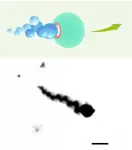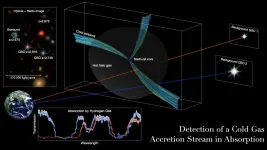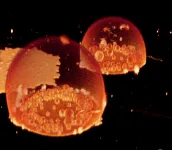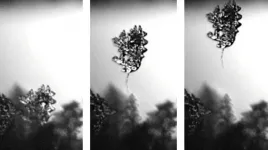Researchers use new tool to study stress in root-colonizing bacteria
Tapping into a plant's microbiome may protect it from harsh growing conditions
2021-02-24
(Press-News.org) LOGAN, UTAH -- One solution to agriculture's many challenges -- climate change-induced drought, less arable land, and decreased water quality, to name a few -- is to develop smarter fertilizers. Such fertilizers would aim not only to nourish the plant but also to maximize soil bacteria's positive effects on the plant. Tapping into a plant's microbiome may be the extra layer of defense crops need to thrive.
In their study published on Dec. 4 in Nature: Scientific Reports, researchers at Utah State University analyzed the effects of two abiotic stressors on Pseudomonas chlororaphis O6 (PcO6), a health-promoting bacterium native to the roots of dryland wheat in northern Utah. They found that stress can cause compositional changes in the bacterium's extracellular structures called outer membrane vesicles, or OMVs. Scientists have long known that bacterial cells release OMVs, but this study asks what factors prompts their release and how the myriad functions of those structures can be leveraged for the crop's benefit.
Key to this study is understanding that bacteria is not always bad.
"There's a lot more emphasis into what's called the 'microbiome revolution,' you know, the fact that you carry four pounds of bacteria on your body right now, and it's not all bad; in fact, it's mainly all good," said David Britt, full professor of biological engineering at Utah State. "Plants also have a microbiome, or 'second genome', and trying to understand how that microbiome interacts with the environment, and its plant host, is very important."
Also key to this study is understanding that stress can be good. The bacterium studied here, for example, protects wheat from drought by forming a film around its roots. But by introducing tiny particles of micronutrients, those benefits could be fortified.
"A little bit of stress is necessary," said Britt. "You can actually prime the whole system to do better under drought."
Equally important to the findings are the instrument and algorithms used in the study. This is the first time that researchers have used Raman spectroscopy to study OMVs from root-colonizing bacteria. "We could have done a lot of expensive assays to figure out all these different things that we were interested in looking at," said Elizabeth Vargis, associate professor of biological engineering at USU.
Instead, Vargis explained, using Raman spectroscopy coupled with a machine learning algorithm enabled them to identify the type of stress the bacteria were experiencing when releasing these OMVs and the stress-dependent compositional changes therein. These observed changes have implications for cell-to-cell communication and bacteria-plant communication, which are essential to better understanding the microbiome.
The study was supported in part by the National Science Foundation, the Utah State University Agriculture Experiment Station and the USDA National Institute of Food and Agriculture, but its implications extend beyond agriculture. Raman spectroscopy supported by the machine learning algorithms is a powerful tool that can be used in any biological study. "A cancer cell in your body will release extracellular vesicles before we can often detect the cancer through other methods," said Britt. "This is a very sensitive technique."
INFORMATION:
[Attachments] See images for this press release:
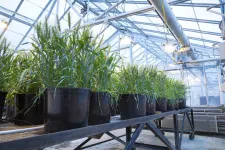
ELSE PRESS RELEASES FROM THIS DATE:
2021-02-24
URBANA, Ill. ¬- In today's global economy, production of goods depends on inputs from many trade partners around the world. Companies and governments need a deeper understanding of the global value chain to reduce costs, maintain a profitable production system, and anticipate ripple effects of disruptions in the supply chain.
Applied economists from the University of Illinois have developed a new model for in-depth analysis of global supply chain linkages across countries and industries, providing a rich tool that delivers valuable insights for businesses and policy makers around the world.
"We live in a time when production processes are very much fragmented. In order to end up with one type of ...
2021-02-24
Researchers have developed a method to estimate the value of oyster and clam aquaculture to nitrogen reduction in a coastal community. Nitrogen is a nutrient that comes from many different sources, including agriculture, fertilizers, septic systems, and treated wastewater. In excess it fuels algal growth, which can affect water quality and human health.
As a result, a growing number of communities are required to follow regulations to reduce the amount of nitrogen they release. Shellfish are an option that can be a valuable part of a community's nutrient management plan.
In a study in Environmental Science ...
2021-02-24
A UNSW Sydney-led medical research team has called for a new vaccine, improved strategies and enhanced monitoring to combat serious complications from childhood pneumonia.
The researchers examined the impact of the 13-valent pneumococcal conjugate vaccine (13vPCV) on childhood pneumonia and empyema - complicated pneumonia - after its introduction to the Australian National Immunisation Program about a decade ago.
The new study, published in Thorax recently, found that while 13vPCV resulted in a 21 per cent decrease in childhood pneumonia hospitalisations, there was a contemporaneous 25 per cent increase in admissions for empyema.
This incidence data for childhood empyema hospitalisations is similar to that reported ...
2021-02-24
For many, 2020 was notorious for the COVID-19 pandemic, but for climate scientists, the year is also infamous for tying with 2016 as the hottest since records began. 'Nine of the warmest years on record have occurred since 2010', says JEB Editor-in-Chief, Craig Franklin. With the ice caps and glaciers melting, devastating bushfires scorching arid regions, and hurricanes and typhoons battering coastal communities, the impact on local ecosystems has been catastrophic. 'Physiologists can play a critical role in the conversation around climate change', says ...
2021-02-24
As part of the Journal of Experimental Biology's Special Issue dedicated to climate change, Anthony Pagano (San Diego Zoo Global, USA) and Terrie Williams (University of California, Santa Cruz, USA), discuss the impact of environmental change on two iconic polar species; the polar bear and narwhal. Their review article is published in Journal of Experimental Biology at https://jeb.biologists.org/content/224/Suppl_1.
Mammals in the Polar Regions face an uncertain future as unprecedented warming drives catastrophic sea ice loss, driving polar bears onto land, after losing access to sea ice and ...
2021-02-24
Rheumatoid arthritis is a chronic inflammatory disorder marked by joint pain, swelling and damage. Although medications, such as steroids, anti-inflammatory drugs and immunosuppressants, can help slow joint destruction and relieve pain, they have side effects and aren't completely successful. Now, researchers reporting in ACS' Nano Letters have developed magnesium-based micromotors propelled by hydrogen bubbles, which improved rheumatoid arthritis symptoms when injected into the joints of rats.
Scientists have linked rheumatoid arthritis development to the excess production of reactive oxygen species (ROS). ROS can oxidize and degrade cartilage and bone, as well as activate the expression of inflammatory cytokines. A new type of therapy, hydrogen gas, can neutralize ROS ...
2021-02-24
To come into being, galaxies need a steady diet of cold gases to undergo gravitational collapse. The larger the galaxy, the more cold gas it needs to coalesce and to grow.
Massive galaxies found in the early universe needed a lot of cold gas--a store totaling as much as 100 billion times the mass of our sun.
But where did these early, super-sized galaxies get that much cold gas when they were hemmed in by hotter surroundings?
In a new study, astronomers led by the University of Iowa report direct, observational evidence of streams of cold gas they believe provisioned these early, massive galaxies. They detected cold gas pipelines that knifed through the hot atmosphere in the dark matter halo of an early massive galaxy, supplying the materials ...
2021-02-24
New research by the University of Oslo provides evidence that the "protocells" that formed around 3.8 billion years ago, before bacteria and single-celled organisms, could have had specialized bubble-like compartments that formed spontaneously, encapsulated small molecules, and formed "daughter" protocells.
ROCKVILLE, MD - Scientists have long speculated about the features that our long-ago single-celled ancestors might have had, and the order in which those features came about. Bubble-like compartments are a hallmark of the superkingdom to which we, and many other species including yeast, belong. But the cells in today's superkingdom have a host of specialized molecules that help make and shape these bubbles inside our ...
2021-02-24
ATLANTA - FEBRUARY 24, 2021 - New study reports that early in the 2020 pandemic in the United States, one-third of cancer survivors worried about treatment and cancer care disruptions. Using a mixed methods approach, investigators utilized survivors' own words to more deeply describe their experiences and worries about the pandemic's impact on their overall health.
The article, appearing in the Journal of Psychosocial Oncology, finds the impact of the pandemic on cancer survivors and the broader health care system is widespread and exacerbated serious gaps in the health care system. For this study, investigators led by Corinne Leach, MPH, MS, PhD, from the American ...
2021-02-24
If you have ever gotten up on a winter morning and thrown yourself into the arduous task of scraping frost from a windshield, a Virginia Tech lab is engaging science [IS1] that could make your life much easier. In research funded by the National Science Foundation, Associate Professor END ...
LAST 30 PRESS RELEASES:
[Press-News.org] Researchers use new tool to study stress in root-colonizing bacteria
Tapping into a plant's microbiome may protect it from harsh growing conditions


